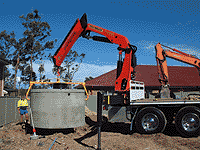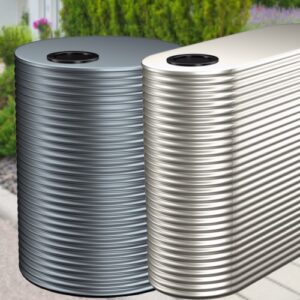Construction of Tanks
Tanks come in a variety of materials:
Concrete
Concrete tanks are strong, long lasting and can be installed underground.
When they are installed underground, the water stays cool and dark and they are not prone to algae or bacteria growth.
They are fire proof and aesthetically pleasing and allow for the use of the above ground space to be utilised for your family, they can even be placed under the driveway!
Polyethylene tanks
Commonly known as ‘poly’ tanks, these tanks come in many sizes and colours and are suitable for both  above and below ground use. They last a long time, are UV-resistant, cost less than metal tanks and, because of their lightweight construction, are easy to transport. They must be constructed of food grade plastics that comply with Australian Standards. They should also be opaque to prevent algae growth. They come in a wide range of shapes, colours and sizes but may not last as long as tanks made of other materials.
above and below ground use. They last a long time, are UV-resistant, cost less than metal tanks and, because of their lightweight construction, are easy to transport. They must be constructed of food grade plastics that comply with Australian Standards. They should also be opaque to prevent algae growth. They come in a wide range of shapes, colours and sizes but may not last as long as tanks made of other materials.
Metal tanks are light and easy to transport, are suitable for above ground use, can be custom made and are usually corrugated. They can be made from a variety of metals including:
- Galvanised steel – zinc-coated Z600 steel (prone to rusting)
- Aquaplate or Colorbond – coloured polymer-coated steel (lasts longest)
- Zincalume – silver-coloured zinc/aluminium-coated steel (prone to rusting)
- Copper and stainless steel – used for specialised applications.
Care must be taken that these surfaces are not damaged when the tank is being cleaned.
Fibreglass tanks
Fibreglass rainwater tanks are resistant to rust and chemical corrosion and are suitable for both ground and stand installations. They are tolerant of extreme temperatures, come in a large range of colours and sizes and, because of their lightweight construction, are easy to transport. Fibreglass tanks can be more expensive than other varieties. They must be opaque otherwise algae will grow. They must be lined with a coating of food grade plastic.
For details on the RainMaster product range please click here.
Tank Size
Choice of tank size is determined by a number of factors:
- The number of people living in your home (if you want to use rainwater for toilet flushing).
- The amount of water you currently use.
- The size of your garden.
- Intended use of rainwater (e.g. garden, toilet flushing).
- Available fittings and components to suit your needs.
- The size of the roof catchment area.
- The location of the property (coastal areas are generally wetter than inland areas so a larger tank is required inland to be as effective as a tank on the coast).
- Local council requirements.
Costs
Apart from purchasing a tank, there are a number of other possible expenses you need to be aware of including:
- delivery
- installation
- gutter, roof and downpipe alterations
- a foundation or tank stand for above ground tanks
- excavation work for below ground tanks
- backflow prevention devices
- a flow regulator
- first flush device, screens and gutter guards
- extra plumbing
- maintenance
- a pump if needed
- a pipe to top up if needed.
After weighing up the cost of a rainwater tank and its associated expenses, you should also consider the long term benefits of purchasing a rainwater tank. This includes the savings in your water consumption costs. Just as importantly, you should also consider that by saving water you are also contributing to preserving our environment.
Maintenance
It’s important to maintain your rainwater tank and components so that they work effectively and reduce the risk of contamination. Preventing problems before they arise will save you time, money and water.
Gutters and roof catchment areas should be regularly inspected and kept clean and clear of leaves and debris. Any overhanging branches should be removed. It’s a good idea to use screens or guards, and these should also be regularly cleaned. Keeping your rainwater screened and flowing cleanly and quickly from your catchment area into your tank reduces the build up of sludge as well as the risk of mosquitoes breeding in your tank.
Check your tank for sludge at least every two to three years. If sludge is covering the bottom of your tank, you’ll need to remove it by siphoning it out or completely emptying your tank (contact a professional tank cleaner if you’re unsure). Excessive sludge build up is a sign of inadequate roof and gutter maintenance. Remember, make sure you prevent mosquito access to your tank. If you find mosquitoes in your tank, find the entry point and close it.
It’s also a good idea to install appropriate screens and guards to stop debris and insects entering the tank. Installing a first flush device is essential for reducing the amount of sediment and other materials entering the tank and polluting the water.
